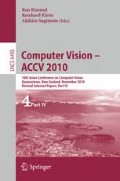Abstract
We propose a novel tracking algorithm for the balance between stability and adaptivity as well as a new online appearance model. Since the update error is inevitable, we present three tracking modules, i.e., reference model, soft reference model and adaptive model, and fuse them using biased multiplicative formula. These three contributors are built through the same appearance model with different update rate. The appearance model, Pixel-wise Spatial Pyramid, employs pixel feature vectors instead of SIFT vectors, to combine several pixel characteristics. In particular, the reserved pixel feature vectors are used to create a new codebook together with the earlier codebook. A hybrid feature map consisting of the reserved pixel vectors and anti-part of previous hybrid feature map is built to represent the new target map. Experimental results show that our approach tracks the object with drastic appearance change, accurately and robustly.
Access this chapter
Tax calculation will be finalised at checkout
Purchases are for personal use only
Preview
Unable to display preview. Download preview PDF.
References
Comaniciu, D., Ramesh, V., Meer, P.: Real-time tracking of non-rigid objects using mean shift. In: CVPR, vol. 2, pp. 142–149 (2000)
Cannons, K., Wildes, R.: Spatiotemporal oriented energy features for visual tracking. In: Yagi, Y., Kang, S.B., Kweon, I.S., Zha, H. (eds.) ACCV 2007, Part I. LNCS, vol. 4843, pp. 532–543. Springer, Heidelberg (2007)
Wang, H., Suter, D., Schindler, K.: Effective appearance model and similarity measure for particle filtering and visual tracking. In: Leonardis, A., Bischof, H., Pinz, A. (eds.) ECCV 2006. LNCS, vol. 3953, pp. 606–618. Springer, Heidelberg (2006)
Ross, D.A., Lim, J., Lin, R.S., Yang, M.H.: Incremental learning for robust visual tracking. Int. J. Comput. Vision 77(1), 125–141 (2008)
Adam, A., Rivlin, E., Shimshoni, I.: Robust fragments-based tracking using the integral histogram. In: CVPR, pp. 798–805 (2006)
Grabner, H., Grabner, M., Bischof, H.: Real-time tracking via on-line boosting. In: BMVC, vol. 1, pp. 47–56 (2006)
Avidan, S.: Ensemble tracking. In: CVPR, vol. 2, pp. 494–501 (2005)
Babenko, B., Yang, M.H., Belongie, S.: Visual tracking with online multiple instance learning. In: CVPR, pp. 983–990 (2009)
Grossberg, S.: Competitive learning: From interactive activation to adaptive resonance. In: NNNI, pp. 213–250 (1998)
Grabner, H., Leistner, C., Bischof, H.: Semi-supervised on-line boosting for robust tracking. In: Forsyth, D., Torr, P., Zisserman, A. (eds.) ECCV 2008, Part I. LNCS, vol. 5302, pp. 234–247. Springer, Heidelberg (2008)
Stalder, S., Grabner, H., Gool, L.V.: Beyond semi-supervised tracking: Tracking should be as simple as detection, but not simpler than recognition. In: ICCV (2009)
Jakob, S., Christian, L., Amir, S., Thomas, P.: Prost: Parallel robust online simple tracking. In: CVPR (2010)
Porikli, F., Tuzel, O., Meer, P.: Covariance tracking using model update based on lie algebra. In: CVPR, pp. 728–735 (2006)
Arif, O., Vela, P.: Non-rigid object localization and segmentation using eigenspace representation. In: ICCV (2009)
Lampert, C.H., Blaschko, M.B., Hofmann, T.: Beyond sliding windows: Object localization by efficient subwindow search. In: CVPR, pp. 1–8 (2008)
Nowak, E., Jurie, F., Triggs, B.: Sampling strategies for bag-of-features image classification. In: Leonardis, A., Bischof, H., Pinz, A. (eds.) ECCV 2006. LNCS, vol. 3954, pp. 490–503. Springer, Heidelberg (2006)
Lazebnik, S., Schmid, C., Ponce, J.: Beyond bags of features: Spatial pyramid matching for recognizing natural scene categories. In: CVPR, pp. 2169–2178 (2006)
Lowe, D.: Distinctive image features from scale-invariant keypoints. Int. J. Comput. Vision 60(2), 91–110 (2004)
Dalal, N., Triggs, B.: Histograms of oriented gradients for human detection. In: CVPR, vol. 1, pp. 886–893 (2005)
Grauman, K., Darrell, T.: The pyramid match kernel: Discriminative classification with sets of image features. In: ICCV, vol. 2, pp. 1458–1465 (2005)
Kwon, J., Lee, K.M.: Visual tracking decomposition. In: CVPR (2010)
Author information
Authors and Affiliations
Editor information
Editors and Affiliations
Rights and permissions
Copyright information
© 2011 Springer-Verlag Berlin Heidelberg
About this paper
Cite this paper
Lu, H., Lu, S., Chen, YW. (2011). Robust Tracking Based on Pixel-Wise Spatial Pyramid and Biased Fusion. In: Kimmel, R., Klette, R., Sugimoto, A. (eds) Computer Vision – ACCV 2010. ACCV 2010. Lecture Notes in Computer Science, vol 6495. Springer, Berlin, Heidelberg. https://doi.org/10.1007/978-3-642-19282-1_14
Download citation
DOI: https://doi.org/10.1007/978-3-642-19282-1_14
Publisher Name: Springer, Berlin, Heidelberg
Print ISBN: 978-3-642-19281-4
Online ISBN: 978-3-642-19282-1
eBook Packages: Computer ScienceComputer Science (R0)

